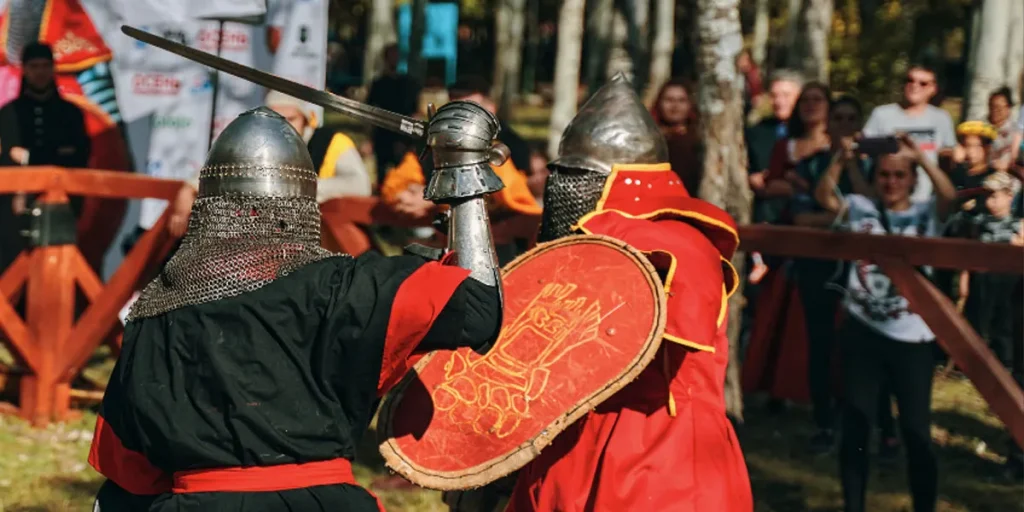A typical longsword weighs between 2.5 to 3.5 pounds (1.1 to 1.6 kilograms). Longswords balance their mass for optimal maneuverability in combat.
Exploring the world of medieval weaponry uncovers the longsword, a weapon that was essential for knights and soldiers from the late medieval period to the Renaissance.
The longsword is characterized by its straight double-edged blade, a cruciform hilt, and a grip that accommodates two-handed use, which was necessary to harness the full potential of this versatile weapon.
Designed for both cutting and thrusting, longswords were crafted to provide a balance of speed, power, and reach in duels and battles.
Their weight was a crucial aspect, enabling a fighter to maintain control without sacrificing mobility.
Owners of longswords spent countless hours training to leverage the sword’s weight, mastering a blend of graceful maneuvers and powerful strikes that made the longsword a renowned tool of war across European battlefields.

The Myth Of The Hefty Blade
Longswords, the iconic weapons of medieval knights, often carry a reputation for weightiness.
Movies and tales abound with scenes of warriors hefting enormous blades, straining with the effort. The image is compelling—the lone hero swinging a massive sword, cutting down foes.
Yet, this portrayal is far from reality. It’s time to explore the truth about longsword weight and challenge the myth of the hefty blade.
Dispelling Exaggerations
Let’s clear the air. In history, swords were not the unwieldy hunks of metal many believe. Instead, they were balanced, precise instruments of warfare.
A typical longsword weighed between 1.1 to 1.8 kg (2.5 to 4 lbs). To be effective, swords had to be maneuverable, capable of quick, controlled swings.
They needed to be light enough to wield without quick exhaustion yet heavy enough to deliver decisive blows.
Cinema Vs. Historical Reality
The silver screen loves its drama, and with that comes embellishment. Filmmakers often opt for swords that feed the narrative of power and might, usually at the expense of historical accuracy.
A cinematic sword might appear to be a towering monument of steel, implying a hero of superhuman strength.
In actuality, a warrior carrying such a weapon would be quickly bested due to its impracticality.
True longswords boasted a graceful design, enhancing a knight’s agility and technique.
This contrast between movie myth and historical fact is stark, revealing a misunderstood aspect of medieval armament.
| Aspect | Cinema | Historical Fact |
|---|---|---|
| Weight | Often exaggerated | Average 1.1 to 1.8 kg |
| Design | Overly bulky | Elegant and balanced |
| Use | Implies brute force | Demands skill and finesse |
Actual Weight Of A Longsword

The longsword, a balanced weapon from history, captivates enthusiasts with its design and usability.
With its intricate craftsmanship, many wonder about its heft. How much does a longsword weigh?
Average Measurements
A typical longsword boasts a length that commands respect, yet its mass remains adept for combat.
Its weight is central to its swinging motion. Let’s look at the numbers behind its weight.
- Length: Generally between 85 to 110 centimeters
- Weight: On average, about 1.1 to 1.8 kilograms
Factors Influencing Weight
Multiple aspects determine the final weight of a longsword. These include:
| Material | Steel types and hilt materials can affect weight. |
|---|---|
| Balance | Distribution between blade and hilt for optimal handling. |
| Construction | Fuller grooves and blade thickness contribute to mass. |
| Era and Region | Historical period and origin influence design and weight. |
Understanding these elements offers insight into the timeless sword’s design. Remember, a longsword’s weight was pivotal for medieval warriors. The balance allowed for swift, precise combat.
Evolution Of The Longsword
The longsword, a blade steeped in history, has changed greatly over centuries. Its weight, design, and usage have adapted with time.
This evolution reveals the longsword’s journey from early medieval origins to its peak of popularity.
Early Medieval Origins
Early longswords were simple yet effective. Craftsmen forged these weapons during a period known as the Dark Ages. They had cruciform hilts and were dual-edged.
- Weight varied between 1.2 to 1.8 kg (2.5 to 4 lbs).
- Blades were approximately 85 to 110 cm (33 to 43 inches) in length.
- Primarily used by knights and nobles.
Peak Of Popularity And Design
The 14th to 16th centuries saw the longsword’s design refinement. Knights favored these weapons in battle for their versatility and power.
| Century | Average Weight | Characteristics |
|---|---|---|
| 14th | 1.5 kg (3.3 lbs) | Longer grips, improved balance |
| 15th | 1.6 kg (3.5 lbs) | Complex hilts for hand protection |
| 16th | 1.4 kg (3.1 lbs) | Sleeker designs, tapered blades |
Different regions fashioned their own distinctive styles. The mighty German Zweihänder and the elegant Italian Spadone are prime examples.
Blacksmiths worked tirelessly to enhance durability and improve handling. The culmination of their efforts was a weapon balanced for cutting and thrusting, serving the needs of soldiers and dueling enthusiasts alike.
Battlefield Utility And Weight

The longsword stands as an iconic weapon of the medieval ages. Its weight plays a crucial role in its efficiency during combat.
Understanding this balance between heft and utility is essential not just for historians but also for enthusiasts and practitioners of historical martial arts.
Balance And Swing Dynamics
In battle, a longsword’s balance determines its swing dynamics. A well-balanced sword allows for swift, controlled movements, essential for both offense and defense maneuvers.
The ideal weight for a longsword typically ranges from 2.5 to 3.5 pounds, allowing a warrior to wield it with both agility and force.
The distribution of this weight, from pommel to tip, can mean the difference between a cumbersome blade and a lethal extension of a soldier’s arm.
- Sword balance is closer to the hilt to aid in maneuverability.
- Weight affects a sword’s responsiveness to the wielder’s actions.
- Blades are constructed for optimal swing speed without sacrificing power.
Armor Penetration And Weight Trade-offs
The effectiveness of a longsword also comes down to its ability to penetrate armor. Heavier swords can deliver more forceful blows, making them more lethal against armored foes.
However, a sword that’s too heavy may be slow and unwieldy, hindering quick responses in the heat of battle.
For this reason, swordsmiths had to carefully consider the trade-offs between a blade’s weight and its piercing capability.
| Sword Weight | Armor Penetration | Speed | Endurance |
|---|---|---|---|
| Lighter | Less force | Higher | Sustained |
| Heavier | More force | Lower | Drained quickly |
Makers of longswords aimed for a sweet spot in weight. This balance allowed the blade to slice through protection without draining the warrior’s stamina rapidly.
Collecting And Replicating Longswords
Antique Longswords Vs. Modern Replicas
Antique longswords, relics of the past, tell stories from the battlefields of the medieval era.
Each one possesses its unique weight, reflecting its own tale and the materials available at the time of its creation.
Their weights vary, typically ranging from 1.2 to 1.8 kilograms.In stark contrast, modern replicas are crafted with both historical accuracy and contemporary requirements in mind.
The market offers a wide weight range for these replicas. But, the true challenge lies in manufacturing a sword that feels right in the hands of its wielder, just as the originals did.
Importance Of Accurate Weight In Replicas
A replica longsword that mirrors the exact weight of an antique counterpart offers the most genuine experience. To practitioners of historical martial arts and lovers of history, every gram matters.
- Handling and Balance: The accuracy of weight affects how the sword cuts through the air and meets its target.
- Historical Integrity: Weight contributes to the overall feel, ensuring the sword is as close to its historical prototype as possible.
- Training and Reenactment: For reenactors, the correct weight is essential for authentic displays of martial prowess.
Manufacturers often use historical texts and surviving antiques to create the most accurate replicas.
They employ various materials, from steel to high-tensile alloys, to match the longsword’s original weight and feel.
Collectors and enthusiasts examine these aspects closely, aiming to hold a piece of history in their hands that feels just right.
The market, therefore, strives to deliver replicas with weights that honor the legacy of the medieval knights who once wielded these majestic blades.
Preserving The Legacy
The longsword, a weapon that whispers tales of chivalry and battle, holds a significant place in history.
Its weight, a physical testament to the strength and skill of yesteryear warriors, often averages between 2.5 to 4.5 pounds.
Preserving and understanding these ancient blades goes beyond admiring their physical attributes.
It involves a deep commitment to maintaining their condition and appreciating their use in modern swordsmanship practices.
Caring For Historical Longswords
To preserve historical longswords, enthusiasts must follow a meticulous regime:
- Avoid touching the blade with bare hands to prevent corrosion.
- Clean the blade with a light oil to protect against rust.
- Use non-abrasive tools for polishing to maintain authenticity.
- Display away from direct sunlight and fluctuating temperatures.
Longsword Sports And Revival Of Swordsmanship
The revival of swordsmanship is flourishing through longsword sports. Clubs and societies dedicated to this art offer a glimpse into the martial prowess of medieval knights. Those engaging in this sport wield replicas, which are:
| Feature | Description |
|---|---|
| Weight | Similar to historical longswords to ensure authentic experience |
| Material | Modern alloys for durability and safety |
| Use | Practiced in controlled environments with appropriate gear |
Competitions and demonstrations offer a platform for sword enthusiasts to connect and share knowledge.
This fosters a community passionate about keeping the art alive. With each swing and parry, participants honor the legacy of the longsword.
FAQs About the Weight of a Longsword
What Is The Average Weight Of A Longsword?
A typical longsword weighs between 2. 5 to 3. 5 pounds. Its design balances between heft for powerful strikes and agility for swift movement.
Understanding its weight is crucial for proper handling and historical accuracy.
How Does Longsword Weight Affect Use?
The weight of a longsword is pivotal for its use; a well-balanced sword allows for both quick, precise maneuvers and substantial force in combat.
The wielder can execute a variety of techniques effectively without undue strain or fatigue.
Can Longswords Be Too Heavy To Handle?
Yes, longswords can be too heavy if they exceed the average weight range. Excessive weight hinders agility and speed, causing user fatigue.
Historically accurate swords are designed to optimize weight for effective usage.
Is The Longsword Weight Suitable For Beginners?
A longsword’s weight is generally manageable for beginners. However, initial guidance on proper stance and technique is recommended to prevent strain.
Starting with lighter models can help novices build strength and skill progressively.
Conclusion
Wrapping up our journey through medieval weaponry, we touched upon the longsword’s heft.
Typically, these blades tip the scales at 2. 5 to 3. 5 pounds, marrying formidable power with agility. Remember, the longsword’s weight was key to historical fencing techniques.
Now you’re equipped to appreciate the sword’s role in history, or even choose one for responsible reenactment. Keep steeling your knowledge, and you’ll slice through medieval myths with ease!
Resources:
https://battlingblades.com/blogs/news/unraveling-the-history-of-the-longsword
